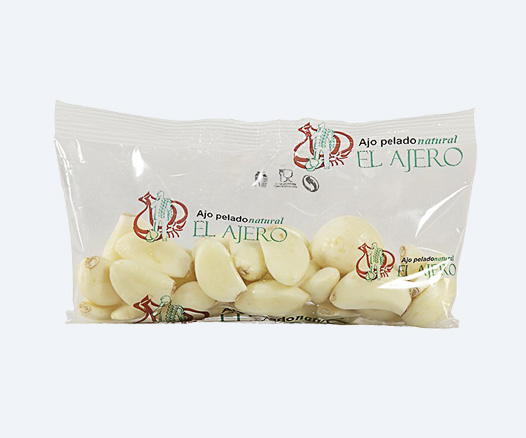Do you consume peeled garlic? Learn more about this product

Learn about the differences between spring and purple garlic
26 February, 2018
Prepare natural fresh garlic pasta and enjoy its benefits for your health
10 March, 2018Do you consume peeled garlic? Learn more about this product
Garlic is a crop widely used as a condiment for the characteristics of its taste and smell. It is used in kitchens around the world and especially in Mediterranean cuisine, where this species usually has much prominence. Garlic is used for consumption since the plant starts to sprout up to the peeled garlic; which is usually used in different ways.
Spain has been one of the countries that cultivates the best quality garlic. Its white garlic, for example, cultivated in Castile and León and Andalusia is a garlic that is cultivated with the utmost care, to which time and effort are dedicated. This species has a slightly spicy flavor, not as strong as purple garlic, but its quality is similar.
Spain’s white garlic can be purchased in commercial establishments around the world in different ways; like creams, sauces, bulbs, peeled, etc. Peeled garlic tends to give guarantees of quality, because the product used for this process is selected and maintains its properties and flavor. Are you interested in knowing more about the subject? Know its properties below.
Properties of peeled garlic
Many products lose their properties when they are not consumed fresh. It is possible that a peeled garlic loses a bit of its beneficial characteristics with time, so it is advisable to use them during the first months. However, white garlic tends to maintain its properties or even improve them during its conservation, especially if the process is refrigerated.
Garlic is a vegetable rich in vitamins A, B1, B2, B6, and C that helps strengthen the immune system, preventing diseases and fighting infections. Likewise, garlic contains minerals such as phosphorus, silicon, sulfur, iron, iodine, manganese, potassium, selenium and amino acids such as lysine, arginine, and valine, among others. This vegetable is free of fats, sodium and cholesterol. It is rich in carbohydrates, proteins and its energy contribution is greater than many other vegetables and greens.
However, the greatest property of garlic is the bactericide and this is due to a compound that is called alliin. When the garlic is crushed or broken, the alliin is transformed into allicin and this is the substance that adds power to fight infections to garlic. In addition to this, garlic supports digestion, has anticoagulant properties, diuretic properties among others. These properties will vary if the garlic is consumed raw or cooked, so it is better to consume it raw.
Uses of peeled garlic
The use of peeled garlic is generally dominated by the meat industry, restaurants, canneries, etc., but it is a product that is purchased domestically for food processing. The peeled garlic tend to be acquired by the people who know their properties or for those people who eat lots of garlic because they like the taste it adds to the meals and prefer to purchase a previously stripped product to save the cumbersome process at home.
Garlic is wonderful and it is very advantageous to buy them peeled. Those who know the benefits of this product use it to develop pesticides, to make mosquito repellents and to attack physical conditions such as athlete’s foot, clean the face, as bait to fish, to remove moles and warts or even as an aphrodisiac and to not having to peel them can be used from the moment of purchase.
What are the steps in picking and peeling garlic?
The garlic intended for the process of peeling are harvested when the bulbs are in a state of maturity. When the stalks are very dry and end up falling is the ideal time to collect the bulbs and proceed to select them. The garlics are placed in mesh to facilitate their transfer to different circuits that are different if the peeling process is manual or includes machinery.
Given the growing demand for peeled garlic, companies in this industry are based on the use of machinery for the process of peeling garlic, which is the following:
– Dry and less fresh garlic bulbs are selected. The bulbs are subjected to a drying process to remove the moisture and place them inside the meshes to proceed to shelling them. Once they are inside the meshes, the first stage of the circuit begins which usually has vibrators that cause the cloves of garlic to come off.
– Afterwards the garlic bulbs go through a shelling process that is usually by centrifugation or incorporated or extreme suction. The speed of the machine will depend on the size of the bulb, this will prevent the grain from breaking and will manage to evacuate the waste that may originate during this process. The better the shelling of the garlic, the much easier and more effective the peeling process will be.
– Once this process is completed, clean and dry grains are selected to continue with the peeling process. There are different peeling processes, among which are dry centrifugation, wet centrifugation. Dry centrifugation tends to be the most used and involves using the lowest air pressure to peel the cloves. This varies according to the size and other characteristics of garlic.
– The peeled cloves go through a manual inspection process in which it is confirmed that they are all peeled, those that do not meet the requirements are returned to the machine. The cloves that comply with the standard are washed to eliminate any residue of shell and to ensure that the cloves have been perfectly treated and are clean.
– Finally, the grains are dried through a drying process at normal temperature. The final product is selected and classified depending on the presentation, the market and even the target audience and proceeds with the product packaging process. Once packaged, the peeled garlic should be kept refrigerated.

